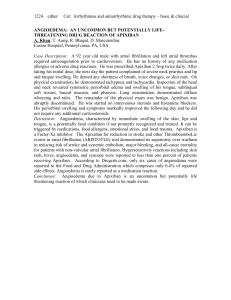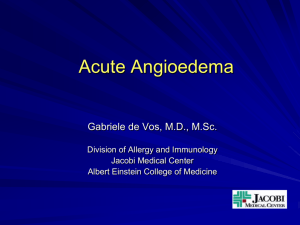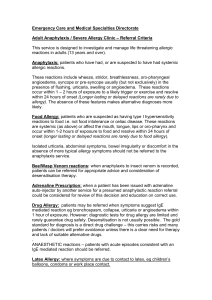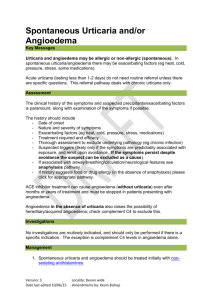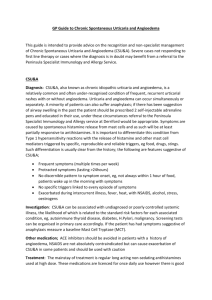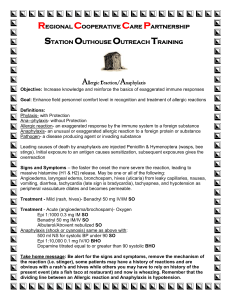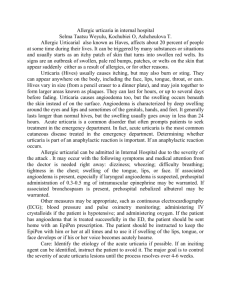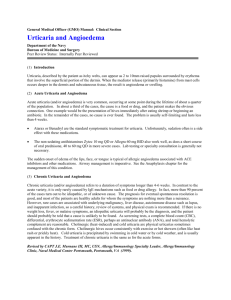Acute Angioedema 8-31-10 Noon Conference
advertisement
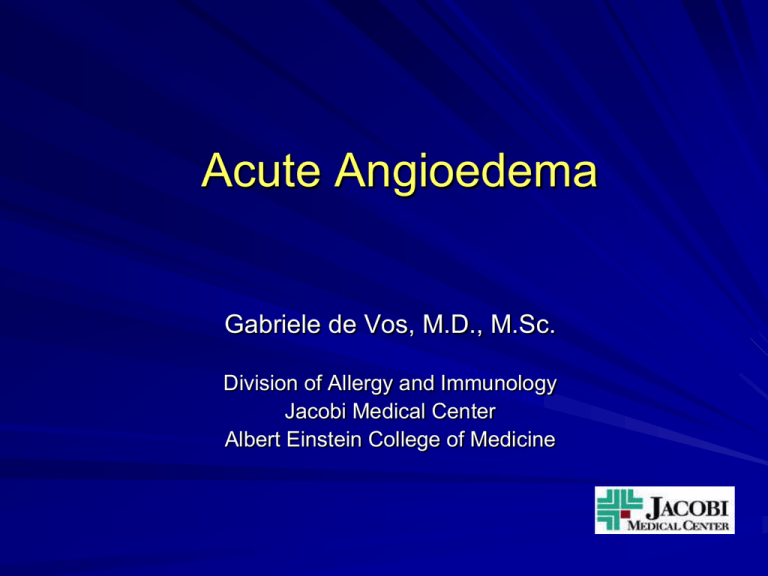
Acute Angioedema Gabriele de Vos, M.D., M.Sc. Division of Allergy and Immunology Jacobi Medical Center Albert Einstein College of Medicine Differential diagnosis of acute angioedema IgE mediated allergic reactions to food, drugs, venoms etc. Histamine-releasing drugs (e.g. opioids, RCM), pseudoallergens in food Adverse reactions to certain medications: NSAIDs, ACE-inhibitors Chronic urticaria with angioedema Idiopathic or exercise induced anaphylaxis C1-Esterase Inhibitor deficiency (hereditary or acquired) Gleich syndrome: recurrent angioedema and high eosinophil counts of unknown etiology Angioedema in hypereosinophilic syndrome Differential diagnosis of acute angioedema IgE mediated allergic reactions to food, drugs, venoms etc. Histamine-releasing drugs (e.g. opioids, RCM), pseudoallergens in food Adverse reactions to certain medications: NSAIDs, ACE-inhibitors Chronic urticaria with angioedema Idiopathic or exercise induced anaphylaxis C1-Esterase Inhibitor deficiency (hereditary or acquired) Gleich syndrome: recurrent angioedema and high eosinophil counts of unknown etiology Angioedema in hypereosinophilic syndrome Differential diagnosis of acute angioedema IgE mediated allergic reactions to food, drugs, venoms etc. – Immediate type (histamine) – Severe reactions (anaphylaxis) almost always occur within 1-30 min – Anaphylaxis is accompanied by skin symptoms in nearly 100% – Up to 20% late phase reaction 2-24 hours (peak 8 hours) How do mast cells release histamine? Presentation of anaphylaxis Cutaneous 90-100% Urticaria and angioedema 85-90% Flush 45-55% Pruritus without rash 2-5% Respiratory 50% Dyspnea 50% Throat tightness and wheezing 54% Rhinitis 15-20% Abdominal Nausea, vomiting, diarrhea, cramping pain 25-30% Other Dizziness, syncope, hypotension 30-35% Headache 7% substernal pain 5% seizure 1% Causes of anaphylaxis Food (e.g. peanuts, tree nuts, shellfish) ~35% Drugs (e.g. antibiotics, NSAIDs, radio contrast media, anaesthetics) Insect bites and stings ~15-20% Latex rare Allergen vaccines rare Exercise induced rare Idiopathic ~30% ~5% Work-up of IgE mediated allergic reactions Skin-testing – Drugs: no standardized skin tests, except penicillin – Food: best with fresh food NPV thought to be generally >95% PPV 50%1 – 95% (milk, egg, peanut, if wheal >8mm)2 – Refractory period up to 4 weeks after anaphylaxis (data from venom anaphylaxis) 1Kagan et al., Ann Allergy Asthma Immunol. 2003 Jun;90(6):640-5 2003 2Sporik R, Hill DJ et al. Clin Exp Allergy. 2000 Nov;30(11):1540-6. Work-up of IgE mediated allergic reactions In vitro sIgE testing – “RAST” (RadioAllergoSorbentTest)outdated test, but term still in use! – Newer tests: Radioactive signal replaced by chemiluminescent reaction (DPC Immulite 2000, PharmaciaCap) – Limited sensitivity and specificity Probability of reacting to egg 100 probability of reaction 90 80 70 60 50 40 30 20 10 0 0 0.35 0.7 3.5 7 sIgE (kU/l) Sicherer et al. 2005 Treatment of severe allergic reactions 1. Epinephrine (Adrenaline) 1:1000 solution (=1mg/ml) – >12 years and adults: 0.3-0.5 mg IM anterolateral thigh; (IV must dilute: 0.10.3 mg (in 10ml) slowly over 10 minutes) – >6 months and <12 years: 0.01 mg/kg 2. Positioning: Keep patient lying flat with legs up unless respiratory distress increases 3. Oxygen supplementation and beta-agonist inhalation (Albuterol) 4. IV access, intravenous fluids (normal saline) if still hypotensive after epinephrine – Remember: 50% of the intravascular volume can be shifted to the extravascular space within the first 10 min. of anaphylaxis – Normal Saline rapid infusion if epinephrine-resistant hypotension 5. If patient is on beta-blocker: Glucagon – Adult: 1-5 mg IV (IM,SC), followed by infusion 5-15 ug/min 6. Antihistamines – Adult: H1-antagonist (Diphenhydramine=Benadryl® 25-50 mg IV) and H2antagonist (Famotidine=Pepcid® 20mg IV) – Children (2-12y): H1-antagonist (Diphenhydramine=Benadryl®1-1.25 mg/kg IV q6h) and H2-antagonist (Famotidine=Pepcid® 0.25-0.5 mg/kg IV q12h) 7. Steroids: do not help acutely but can prevent prolonged anaphylaxis Liebermann et al. “The diagnosis and management of anaphylaxis. An updated practice parameter”, JACI 2005; 115 Differential diagnosis of acute angioedema IgE mediated allergic reactions to food, drugs, venoms etc. Histamine-releasing drugs (e.g. opioids, RCM), pseudoallergens in food Adverse reactions to certain medications: NSAIDs, ACE-inhibitors Chronic urticaria with angioedema Idiopathic or exercise induced anaphylaxis C1-Esterase Inhibitor deficiency (hereditary or acquired) Gleich syndrome: recurrent angioedema and high eosinophil counts of unknown etiology Angioedema in hypereosinophilic syndrome Differential diagnosis of acute angioedema Food that can enhance allergic skin reactions: 1.Any spices and seasoning such as Sazon, Adobo, Vegeta, ginger, garlic, onion or celery powder, any MSG containing food (e.g. Chinese food) etc. 2.Premixed dressings for salads such as 1000 islands, blue cheese, French dressing etc. (Only oil and a touch of vinegar or lemon juice should be used for salad dressing) 3.Canned tomatoes, tomato sauce or paste, canned soups, other canned meals 4.Vinegar and vinegar-containing foods such as mayonnaise, ketchup, and mustard, salad dressings, chili, shrimp sauce, pickles, pickled vegetables, relishes, green olives, and sauerkraut. 5.Beer, wine and cider 6.Mushrooms. 7.Soy sauce. 8.Pickled and smoked meats and fish including sausages, bacon, ham, hot dogs, corned beef, pastrami, and pickled tongue. 9.Lobster and shellfish. 10.Soured breads (e.g. pumpernickel, rye) fresh rolls, coffee cakes 11. Certain fruits such as melons, especially cantaloupe, mango, all tropical fruit (pineapple, papaya etc.), grapes, strawberries 12.All dried and candied fruits including raisins, apricots, dates, prunes, and figs. 13.Diet soda, sodas containing artificial coloring (in particular orange and grape, mountain dew), ginger ale, Snapple, fruit punches of any kind, iced tea, any powdered drinks, health food preparations, any herbal teas (e.g. ginger or lemon or orange spice tea), herbal medicines, vitamins or tonics unless prescribed. 14.Chocolate, nuts, peanut products, chewing gum, breath mints, candy 15. Milk and milk products; Cheeses, in particular aged cheeses, in some cases also cottage cheese, sour cream, and buttermilk Histamine-releasing drugs (e.g. opioids, RCM), pseudoallergens in food. – Immediate or delayed onset of symptoms – Mechanism not well understood – Opiates, radio contrast media and vancomycin are typical examples – There is increasing data that certain food can trigger histamine release in susceptible individuals (e.g. chronic urticaria) Differential diagnosis of acute angioedema IgE mediated allergic reactions to food, drugs, venoms etc. Histamine-releasing drugs (e.g. opioids, RCM), pseudoallergens in food Adverse reactions to certain medications: NSAIDs, ACE-inhibitors Chronic urticaria with angioedema Idiopathic or exercise induced anaphylaxis C1-Esterase Inhibitor deficiency (hereditary or acquired) Gleich syndrome: recurrent angioedema and high eosinophil counts of unknown etiology Angioedema in hypereosinophilic syndrome Mechanism of action of NSAIDs (non selective Cox-inhibitors) Cell stimulation Phospholipase A2 activation Release of arachidonic acid lipoxygenase Leukotrienes Angioedema Bronchoconstriction and vascular permeability X Cyclooxygenase-1 COX inhibitors (NSAID) Prostaglandins Bronchodilation Mechanism of action of ACE inhibitor ACE-inhibitor NOSNO Angioedema Differential diagnosis of acute angioedema IgE mediated allergic reactions to food, drugs, venoms etc. Histamine-releasing drugs (e.g. opioids, RCM), pseudoallergens in food Adverse reactions to certain medications: NSAIDs, ACE-inhibitors Chronic urticaria with angioedema Idiopathic or exercise induced anaphylaxis C1-Esterase Inhibitor deficiency (hereditary or acquired) Gleich syndrome: recurrent angioedema and high eosinophil counts of unknown etiology Angioedema in hypereosinophilic syndrome Differential diagnosis of acute angioedema IgE mediated allergic reactions to food, drugs, venoms etc. Histamine-releasing drugs (e.g. opioids, RCM), pseudoallergens in food Adverse reactions to certain medications: NSAIDs, ACE-inhibitors Chronic urticaria with angioedema Idiopathic or exercise induced anaphylaxis C1-Esterase Inhibitor deficiency (hereditary or acquired) Gleich syndrome: recurrent angioedema and high eosinophil counts of unknown etiology Angioedema in hypereosinophilic syndrome C1 inhibitor deficiency (hereditary or acquired) – Hereditary: au.-dom.,can begin in childhood, ~1:30.000 30% new mutations Depending on gene defect either type I (deficient quantitative production) or type II (deficient qualitative production); type III with nl C1 inh recently described in women, still poorly understood – Acquired: over utilization of the normal C1 inhibitor by high levels of antigenantibody complexes factors formed by lymphoid tumors that destroy C1-INH activity autoantibody to the C1-INH that prevents its function Attacks are typically triggered by trauma (e.g. dental surgery), infection, stress, ACE inhibitors, etc. The role of C1 inhibitor and available treatments Morgan, NEJM 2010 The role of C1 inhibitor and available treatments • C1 inhibitor concentrates: Cinryze® (pateurized, nanofiltered C1 inh concentrate approved for prophylaxis of attacks; studies showed 50% reduction in severity and frequency of attackes (50%) if infused twice weekly • Attenuated Androgens (danazol, stanazol): increase C1 inh production in liver • Antifibrinolytic agents (tranexamic acid, epsilonaminocaproic acid): inhibit plasminogen activation with consequent “sparing” of C1 inh usage Complement levels in C1 inhibitor deficiency Angioedema syndrome Complement component levels C1q C4* C2* C1-inhibitor functional/antige nic HAE type 1 normal low low low/low HAE type 2 normal low low low/normal Aquired low low low low/variable *during attack Questions ? In vitro sIgE-testing Allergen Decision point (spec. IgE kU/l) PPV Egg 7 98 Egg infant < 2y 2 95 15 95 Milk Milk infant < 2y 5 Peanut 14 100 Fish 20 100 Soybean 30 73 Wheat 26 74 tree nuts 15 95 Sampson et al. JACI 2003.111:S542
